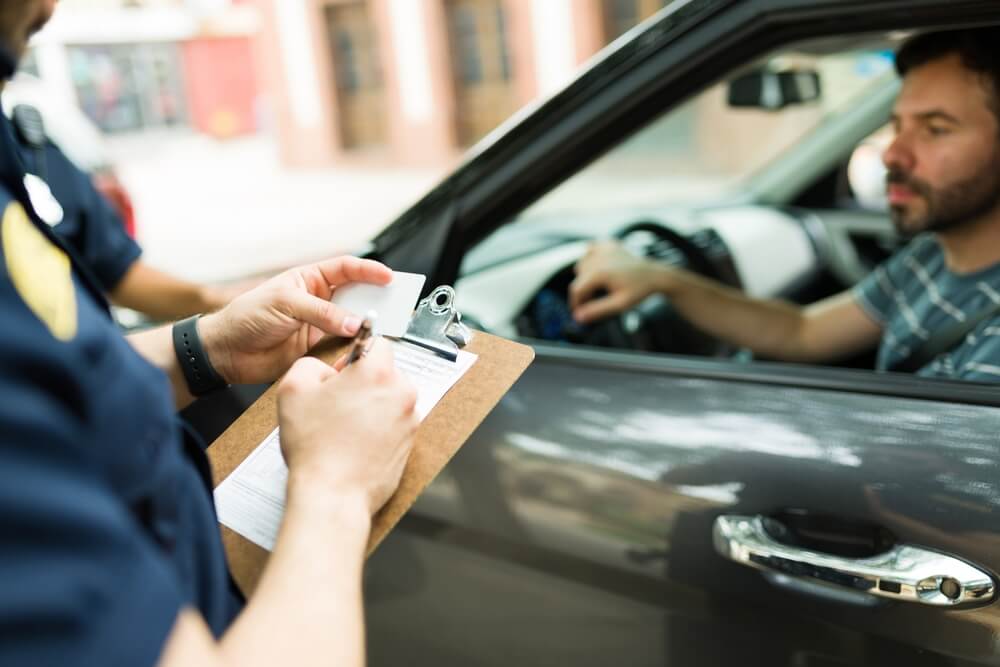
If you are not redirected within 30 seconds, please click here to continue.
Samedi: 10h – 16h HAE

If you are not redirected within 30 seconds, please click here to continue.
If you are not redirected within 30 seconds, please click here to continue.
What happens to your insurance when you get two traffic tickets in one stop?

On a busy morning, a parent rushing to get their child to school might not notice their little one fiddling with their seatbelt until it pops open. Add the possibility of accidentally rolling through a stop sign, and what seemed like minor slip-ups can quickly escalate — especially if a police car is nearby.
Getting pulled over and receiving not one, but two tickets during a single stop can feel overwhelming. But it’s important to understand how these tickets are handled and what your options are.
While the immediate consequences of a traffic violation are the potential fines and docked demerit points, it will show up in your insurance. You might face a 10–25% hike in your premiums—or worse, be reclassified as a high-risk driver. That label can make coverage more expensive or harder to secure. And if you had a clean driving discount, you’ll have to be extra cautious for another six years before getting it back.
However, not every conviction carries the same consequences. Learn what happens – and what your options are – when you receive two tickets in one stop.
What are your legal options?
When you receive a ticket for a traffic violation, you usually have three legal options:
- Plead guilty and pay the fine.
- Plead guilty but ask the court for a lower fine or more time to pay.
- Plead not guilty and request a trial to fight the charge.
If you plead guilty—whether you pay right away or ask for a break on the fine—the ticket becomes a conviction on your driving record. So, if you get two tickets at once, pleading guilty means you’ll have two separate convictions on your record.
If you plead not guilty and choose to go to trial, you’ll have a chance to defend yourself in court. If you’re successful, the Crown Attorney may agree to drop one of the charges. But even if that happens, the remaining conviction can still affect your car insurance rate—and you’ll still have a fine to pay.
How do two convictions affect insurance premiums?
Traffic convictions stay on your driving record for three years in most provinces. Insurance companies look at your record when setting your premium, and two convictions—especially close together—can make you seem like a higher-risk driver.
Not all tickets are treated the same. Some are considered minor, like not wearing a seatbelt or rolling through a stop sign. Others are major, like running a red light or speeding in a school zone.
Criminal offences, like careless or impaired driving, can have the biggest impact.
Even two minor convictions can cause your insurance premium to go up. For example:
- One minor conviction might cost you a discount.
- Two or more could raise your rate by 10–20%.
- A major conviction could increase your premium by 25% or more.
- Multiple convictions might even label you a “high-risk” driver, which can double your rate or make it harder to find coverage.
Related: Major or minor traffic conviction — What’s the difference?
How much would common infractions cost you?
Common traffic infractions, like seatbelt violations and red-light offences, can come with hefty fines, demerit points, and potential impacts on your insurance. Here’s what they’d cost you:
1.Failing to wear a seatbelt;
| Location | Fine | Demerit Points |
|---|---|---|
| Ontario | $200 | 2 |
| Alberta | $162 | 2 (for GDL drivers if passengers exceed the number of seatbelts) |
Common traffic infractions, like seatbelt violations and red-light offences, can come with hefty fines, demerit points, and potential impacts on your insurance. Here’s what they’d cost you:
If someone under 16 in your vehicle isn’t wearing a seatbelt, you, as the driver, will be charged. For younger children, car seats and booster seats are your child’s best protection when in a vehicle. When installed and used properly, child car seats and booster seats can help reduce the risk of a child being injured or killed in a collision.
2. Running a red light: Police officer vs. red light camera ticket
When it comes to running a red light, the type of ticket you receive can have different consequences for your driving record and insurance rates. Here’s a clear breakdown of how they differ:
Ontario
| Type | Police officer issued ticket | Red light camera |
|---|---|---|
| Fine | $260 | $328 |
| Demerit points | 3 (novice drivers receive 4) | 0 |
| Insurance impact | Yes | No |
| Driving record | Yes | No |
- Key differences:
A red-light ticket issued by a police officer will appear on your driving record and include demerit points, which can lead to higher insurance premiums. On the other hand, a red-light camera ticket only results in a fine and does not impact your driving record or insurance rates.
Alberta
| Category | Police Officer Issued Ticket | Red Light Camera Ticket |
|---|---|---|
| Fine | $338 | $405 |
| Demerit Points | 3 | 0 |
| Insurance Impact | Yes | No |
| Driving Record | Yes | No |
- Key differences:
Just like in Ontario, receiving a ticket from a police officer in Alberta will impact your driving record and may lead to increased insurance premiums due to the demerit points. Red-light camera tickets, however, do not carry demerit points or insurance consequences.
While both types of tickets come with financial penalties, tickets issued by a police officer can have long-term implications on your insurance rates. A clean driving record is key to keeping your premiums low, so it’s important to understand these distinctions and drive cautiously to avoid infractions.
3. Failure to stop at a stop sign
Failing to stop properly at a stop sign is another common infraction that can have financial and insurance repercussions.
| Province | Fine | Demerit Points | Insurance Impact | Driving Record |
|---|---|---|---|---|
| Ontario | $110 ($120 in safety zones) | 3 | Insurance premiums may increase, especially if it’s not your first offence, signaling risky driving behavior. | Conviction recorded |
| Alberta | $388 | 3 | Minor violation; may increase rates if combined with other infractions. | Conviction recorded |
Rolling through a stop sign or failing to come to a full stop can trigger an insurance premium increase, even when it’s considered a minor infraction.
Learn more: The best way for high-risk drivers to get car insurance
What if you get two infractions at once?
Getting two tickets during a single stop—like not wearing a seatbelt and running a red light —can multiply the consequences quickly.
Here’s how it adds up:
- Double the fines: You’ll need to pay each fine separately. For example, a red light ticket ($328.25 in Ontario) plus a seatbelt violation ($200 per passenger, including driver) could cost you over $500 in one stop.
- Stacked demerit points: Demerit points from each ticket are combined. Two minor infractions could result in 4–6 points, which may trigger warnings or license suspensions for new drivers.
- Insurance impact: Each conviction is recorded separately. Two convictions—even if minor—can push you into a higher-risk category, potentially raising your premium by 10–25% or more.
- Court strategy: If you choose to fight the tickets, you may be able to negotiate with the Crown Attorney to drop one charge in exchange for pleading guilty to the other. This could reduce the long-term impact on your insurance.
Will demerit points influence my car insurance premium?
While demerit points don’t directly affect your insurance rate, the violations that result in them certainly do. Insurers focus on infractions because they indicate potential risk, which is a key factor in premium calculations.
Many factors go into calculating your insurance premium, including how long you've been driving, where you live, your age, and your vehicle type. But your driving history weighs heavily. The better your record, the lower your premium.
Ultimately, your best defence against an increase in your auto insurance rates is to avoid traffic convictions altogether.
Don't waste time calling around for auto insurance
Use Rates.ca to shop around, and compare multiple quotes at the same time.
Get money-saving tips in your inbox.
Stay on top of personal finance tips from our money experts!









